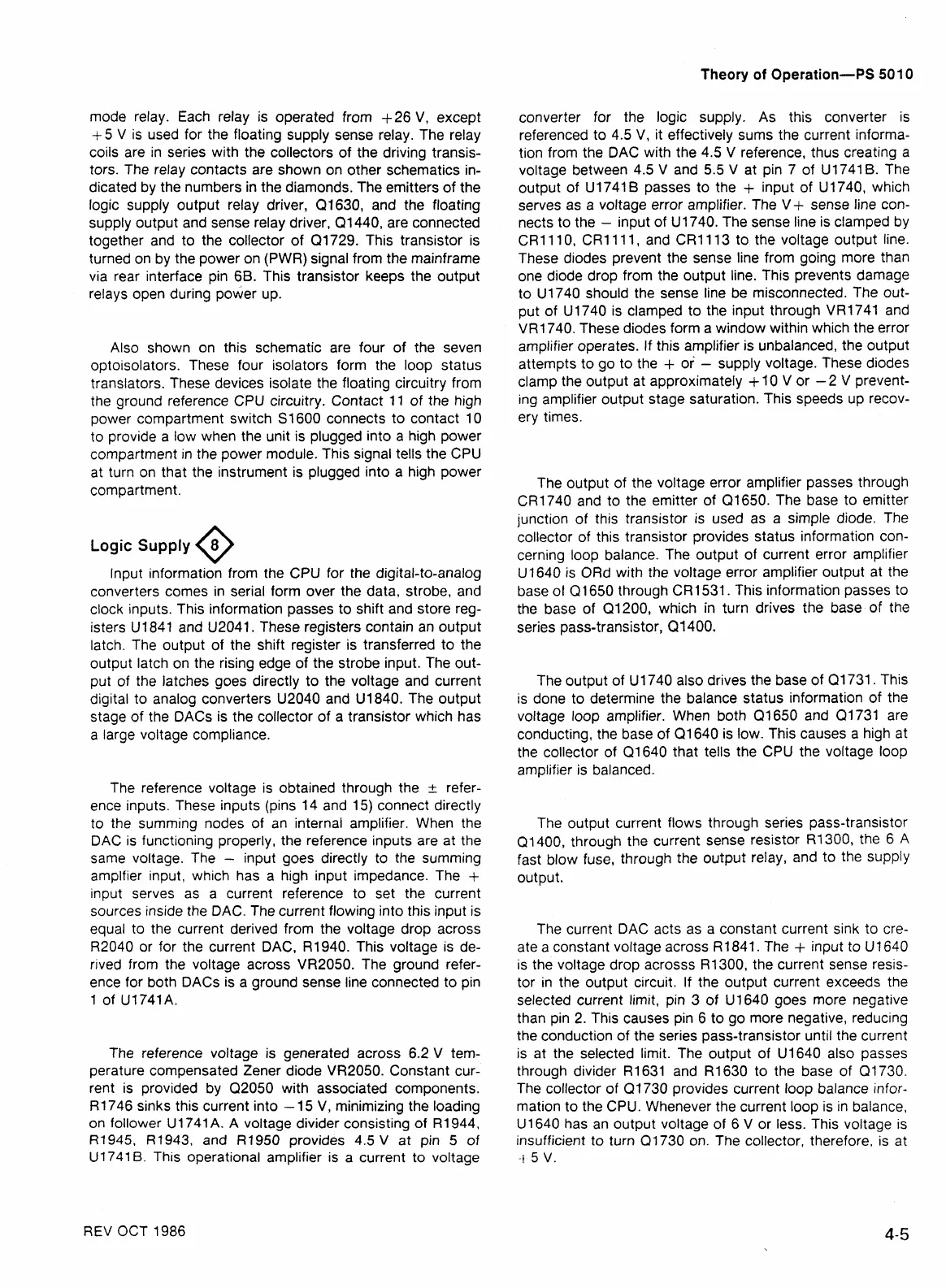Theory
of
Operation-PS
501
0
mode relay. Each relay is operated from
$26
V, except
+5 V
is used for the floating supply sense relay. The relay
coils are in series with the collectors of the driving transis-
tors. The relay contacts are shown on other schematics in-
dicated by the numbers in the diamonds. The emitters of the
logic supply output relay driver,
(21630,
and the floating
supply output and sense relay driver,
Q1440,
are connected
together and to the collector of
Q1729.
This transistor is
turned on by the power on
(PWR)
signal from the mainframe
via rear interface pin
6B.
This transistor keeps the output
relays open during power up.
Also shown on this schematic are four of the seven
optoisolators. These four isolators form the loop status
translators. These devices isolate the floating circuitry from
the ground reference
CPU
circuitry. Contact
11
of the high
power compartment switch
S1600
connects to contact
10
to provide a low when the unit is plugged into a high power
compartment in the power module. This signal tells the
CPU
at turn on that the instrument is plugged into a high power
compartment.
Input information from the
CPU
for the digital-to-analog
converters comes in serial form over the data, strobe, and
clock inputs. This information passes to shift and store reg-
isters
U1841
and
U2041.
These registers contain an output
latch. The output of the shift register is transferred to the
output latch on the rising edge of the strobe input. The out-
put of the latches goes directly to the voltage and current
digital to analog converters
U2040
and
U1840.
The output
stage of the
DACs
is the collector of
a
transistor which has
a large voltage compliance.
The reference voltage is obtained through the
-+
refer-
ence inputs. These inputs (pins
14
and
15)
connect directly
to the summing nodes of an internal amplifier. When the
DAC
is functioning properly, the reference inputs are at the
same voltage. The
-
input goes directly to the summing
amplfier input, which has a high input impedance. The
+
input serves as a current reference to set the current
sources inside the
DAC.
The current flowing into this input is
equal to the current derived from the voltage drop across
R2040
or for the current
DAC, R1940.
This voltage is de-
rived from the voltage across
VR2050.
The ground refer-
ence for both
DACs
is a ground sense line connected to pin
1
of
U1741A.
The reference voltage is generated across
6.2
V
tem-
perature compensated Zener diode
VR2050.
Constant cur-
rent is provided by
(22050
with associated components.
R1746
sinks this current into
-
15 V,
minimizing the loading
on follower
U1741
A.
A
voltage divider consisting of
R1944,
R1945, R1943,
and
R1950
provides
4.5
V
at pin
5
of
U1741
B.
This operational amplifier is
a
current to voltage
converter for the logic supply.
As
this converter is
referenced to
4.5 V,
it effectively sums the current informa-
tion from the
DAC
with the 4.5 V reference, thus creating a
voltage between
4.5
V
and
5.5 V
at pin
7
of
U1741 B.
The
output of
U1741
B
passes to the
+
input of
U1740,
which
serves as a voltage error amplifier. The
V+
sense line con-
nects to the
-
input of
U1740.
The sense line is clamped by
CR1110, CR1111,
and
CR1113
to the voltage output line.
These diodes prevent the sense line from going more than
one diode drop from the output line. This prevents damage
to
U1740
should the sense line be misconnected. The out-
put of
U1740
is clamped to the input through
VR1741
and
VR1740.
These diodes form a window within which the error
amplifier operates. If this amplifier is unbalanced, the output
attempts to go to the
+
or
-
supply voltage. These diodes
clamp the output at approximately
+
10
V or
-2
V prevent-
ing amplifier output stage saturation. This speeds up recov-
ery times.
The output of the voltage error amplifier passes through
CR1740
and to the emitter of
Q1650.
The base to emitter
junction of this transistor is used as a simple diode. The
collector of this transistor provides status information con-
cerning loop balance. The output of current error amplifier
U1640
is
ORd
with the voltage error amplifier output at the
base of
Q1650
through
CR1531.
This information passes to
the base of
Q1200,
which in turn drives the base of the
series pass-transistor, Q1400.
The output of
U1740
also drives the base of
01 731.
This
is done to determine the balance status information of the
voltage loop amplifier. When both
(21650
and
(21731
are
conducting, the base of
01640
is low. This causes a high at
the collector of
Q1640
that tells the
CPU
the voltage loop
amplifier is balanced.
The output current flows through series pass-transistor
Q1400,
through the current sense resistor
R1300,
the
6
A
fast blow fuse, through the output relay, and to the supply
output.
The current
DAC
acts as a constant current sink to cre-
ate a constant voltage across
R1841.
The
+
input to
U1640
is the voltage drop acrosss
R1300,
the current sense resis-
tor in the output circuit. If the output current exceeds the
selected current limit, pin
3
of
U1640
goes more negative
than pin
2.
This causes pin
6
to go more negative, reducing
the conduction of the series pass-transistor until the current
is at the selected limit. The output of
U1640
also passes
through divider
R1631
and
R1630
to the base of
Q1730.
The collector of
Q1730
provides current loop balance infor-
mation to the
CPU.
Whenever the current loop is in balance,
U1640
has
an output voltage of
6
V
or less. This voltage is
insufficient to turn
Q1730
on. The collector, therefore, is at
-1
5
v.
REV
OCT
1986
